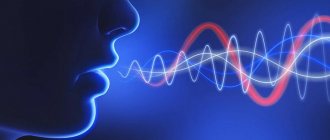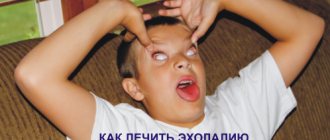Stuttering. Examples
Author: Olga Eletskaya
Speech spasms
Spasms of the muscles of the speech apparatus during oral speech are the main symptom of stuttering. Speech spasms occur only at the moment of speech or when trying to start speech and are expressed in involuntary contraction of the muscles of the speech apparatus. Spasms of the muscles of the speech apparatus have different localization, type and severity.
It is customary to distinguish two main types of speech spasms: tonic and clonic.
Tonic speech convulsions manifest themselves in the form of a violent sharp increase in muscle tone, usually involving several muscle groups (for example, muscles of the tongue, lips, cheeks, etc.). The person who stutters seems to be shackled at these moments. In this case, the mouth can be half-open or, on the contrary, the lips are tightly closed. The face reflects the great tension that a stutterer puts into starting or continuing speech. Acoustically, a tonic spasm manifests itself as a long pause in speech, or as a tense and drawn-out vocalization.
Clonic speech convulsions are characterized by violent repeated rhythmic contractions of the muscles of the speech apparatus. In this case, a person who stutters usually repeats individual sounds or syllables.
Typically, clonic and tonic speech spasms are observed in the same person who stutters.
Localization of seizures
Muscle spasms of the speech apparatus can manifest themselves in all parts of the speech apparatus: articulatory, vocal and respiratory. Accordingly, it is customary to talk about articulatory, vocal and respiratory spasms. In the clinical picture of stuttering, especially when a speech defect is chronic, mixed convulsions are more common: respiratory-articulatory, respiratory-vocal, articulatory-vocal, etc.
Until now, it is generally accepted that the classic description of speech convulsions during stuttering is presented in the monograph by A.I. Sikorsky “On stuttering” (1889). They identified 16 forms of various speech convulsions depending on their location.
Respiratory spasm
- Inspiratory spasm. It is characterized by a sudden sharp breath that occurs at different stages of a speech utterance, which leads to an unreasonable pause. Inspiratory clonic convulsions can follow each other without interruption by exhalation. These spasms impair both phonation and speech articulation. The strength of inspiratory convulsions varies. Most often they are weakly expressed and acoustically inconspicuous. Only in very rare cases are they strong and long lasting. Inspiratory spasms are usually accompanied by subjective sensations of stutterers in the form of a feeling of tension in the chest.
- Expiratory spasm. Characterized by a sudden sharp exhalation during speech utterance. It is characterized by strong contractions of the abdominal muscles. During an attack of expiratory spasm, a stutterer may sharply lean forward, and air passes sharply and noisily through the open glottis. During an expiratory spasm, both articulation and vocalization are suspended. Subjectively, people who stutter experience a painful sensation of unusual chest compression and lack of air. In the case of significant duration and severity of tonic muscle tension, the structure of the expiratory spasm includes the opening of the glottis, lowering of the lower jaw, raising of the velum and swelling of the wings of the nose.
Vocal convulsions
Convulsions of the vocal apparatus usually occur when attempting to pronounce a vowel sound.
There are three main types of vocal apparatus spasms.
- A vocal closure spasm occurs when trying to start speaking or in the middle of a speech utterance, which suddenly stops vocal production. During a spasm, the vocal folds close sharply, preventing the passage of air. The main symptom of this type of seizure is the complete absence of sound, which can vary in duration. During this period, a sort of “fleeting dumbness” sets in. Due to the fact that the glottis is closed, the passage of the air stream is blocked, and the abdominal muscles are tense. The person who stutters seems to “freeze”, his face becomes motionless, the muscles of the entire body become numb. With a prolonged vocal constriction, the stutterer's face looks tense. As objective sensations, stutterers may indicate a feeling of tension in the larynx, chest and abdominal muscles, a feeling of obstruction in the larynx.
- Vocal spasm occurs in the form of increased tone of the vocal muscles. A spasm occurs during speech, usually on vowel sounds.
- Acoustically, a vocal twitch is perceived as an unusual duration of vocalization of a vowel sound. According to A.I. Sikorsky, this form most often occurs in the initial stage of stuttering in children and may be the first sign of incipient stuttering, and is also a harbinger of future respiratory and articulatory spasms. Sometimes the duration of a vocal spasm exhausts the entire reserve amount of air, and the word cannot be pronounced without a new breath. With vocal spasms, the timbre of the voice and its frequency characteristics may not be impaired, but sometimes people who stutter experience a vocal spasm, during which the timbre of the voice and its pitch may change. The voice acquires an unpleasant, falsetto-like sound, sometimes falling, sometimes rising. A vocal spasm, localized in the larynx, can seize the neck muscles and disrupt the activity of all muscles of the vocal apparatus. Sometimes there is a complete suspension of articulatory movements until the vocal spasm ends. A trembling or jerky laryngeal spasm occurs when pronouncing or attempting to pronounce vowel sounds. In this case, speech is interrupted, a trembling or intermittent sound occurs, which is accompanied by a complete lack of articulation. Sometimes sounds are heard in the form of separate slow “beats”. During a trembling laryngeal spasm, the vocal folds alternately close and open, resulting in non-phonological sounds. This spasm is characterized by an open mouth, which may be accompanied by a rhythmic throwing back or lowering of the head forward.
Convulsions of the articulatory apparatus
Articulatory spasms are divided into facial (lips, lower jaw), lingual and soft palate spasms.
Facial spasms
The lip closure spasm is one of the most commonly observed spasms in stuttering. It is already characteristic of the early stages of development of this speech disorder. A lip closure spasm manifests itself in the form of a spasm of the orbicularis oris muscle, as a result of which the lips are strongly compressed, while other facial muscles may not take part in the spasm. When trying to pronounce sounds, the cheeks may inflate under the pressure of air filling the oral cavity. With a closing spasm of the lips, the pronunciation of labial sounds (p, b, m, v, f) is impaired. In severe cases, the spasm also disrupts the pronunciation of sounds that are localized as lingual (t, d, k).
Upper labial spasm is rare. It manifests itself as a spasm of the muscles that raise the upper lip, and sometimes the wings of the nose. It occurs more often on one side of the face, with the oral fissure taking an oblique direction. The upper labial spasm is often tonic in type. With this convulsion, the pronunciation of all labial sounds is almost impossible. The face becomes asymmetrical and distorted. The lower labial cramp is similar to the upper labial cramp. Affects one or both muscles of the depressor anguli oris. If both muscles are affected, a sharp turn of the lower lip is observed. Rarely observed in isolation. Angular spasm of the mouth is characterized by a sharp pulling of the corner of the mouth to the right or left along with its lifting. The oral fissure twists towards the convulsively contracted muscles. The spasm may spread to the muscles of the nose, eyelids, and forehead.
An angular spasm disrupts the functioning of the orbicularis oris muscle. A person who stutters during a convulsion is unable to close his lips, as a result of which the pronunciation of the corresponding consonants is disrupted. Angular mouth spasm can occur on both sides of the mouth. It can be either tonic or clonic.
Convulsive opening of the oral cavity can occur in two ways:
a) the mouth opens wide with a simultaneous lowering of the lower jaw;
b) when the jaws are closed, the teeth are sharply exposed.
The outline of the mouth takes on a square shape. All muscles of the articulatory apparatus are extremely tense. The spasm is usually tonic in nature and often radiates and can involve the muscles of the forehead, eyelids and all the muscles of the face.
Complex facial spasm
Although I.A. was singled out. Sikorsky into a separate spasm, however, in his opinion, does not have independent significance, but is one of the manifestations of various severe facial spasms, including spasms of the frontal muscles, the orbicularis eyelid muscle, and the ear muscles. A complex facial spasm usually accompanies a spasm of the orbicularis oris muscle. According to a number of researchers, it is characteristic of severe stuttering in adults.
Tongue cramps
They constitute the second group of convulsions of the articulatory apparatus and are observed, as a rule, when pronouncing sounds in the articulation of which the tongue takes part.
There are several types of tongue cramps.
Tongue tip spasm is the most common articulatory spasm. The tip of the tongue rests with tension on the hard palate, as a result of which articulation is suspended, exhalation (and, therefore, phonation) stops at this moment, and an unreasonable pause occurs.
Convulsive lifting of the tongue root is expressed in the forcible lifting of the tongue root upward and pulling back. During a convulsion, the root of the tongue closes with the palate, as a result of which the passage of the air stream through the mouth is completely blocked. This spasm occurs when pronouncing back-lingual sounds (g, k, x).
A tongue expulsion spasm is characterized by the tongue being pushed outward into the space between the teeth. It can be tonic and clonic. With a tonic spasm, the tongue may be protruding from the mouth, and with a clonic spasm, it may periodically move forward and then be forcefully pulled inward. During a convulsion, making sounds becomes impossible, breathing is disrupted, and even pain may occur. If the spasm is not pronounced, the tongue may remain in the mouth, only resting against the teeth. Sublingual spasm is characterized by lowering of the lower jaw and opening of the mouth. This spasm involves the muscles associated with the hyoid bone. With this spasm, repetition of syllables and aspiration is often observed. Very rarely it is independent in nature and is mainly combined with seizures of other localizations.
Spasm of the soft palate
This spasm is extremely rare in isolation. More often it is observed as part of a complex generalized convulsion of the articulatory apparatus. During a spasm, the soft palate rises and falls, causing the entrance to the nasal cavity to open and close, giving the sounds a nosalized tone. Externally, a spasm is expressed by a sudden stop of speech and repetition of sounds similar to “pm-pm” or “tn-tn”, “kn-kn”, etc. depending on the position of the tongue and lips.
Subjective sensations of people who stutter are expressed in a feeling of unpleasant tension, rawness and dryness in the nose.
Severity of manifestation of speech cramps
There are severe, moderate and mild degrees of seizures. The assessment of the severity of convulsive activity of the muscles of the speech apparatus may not coincide with the assessment of the severity of stuttering, since this concept includes many factors. To date, there are no objective indicators and a unified methodology for assessing the severity of stuttering.
There are different opinions of experts on this matter. Many practitioners believe that the severity of stuttering is determined by the ability to speak fluently in certain types of speech load.
Thus, a mild degree of stuttering is qualified if convulsive hesitations are observed only in spontaneous coherent speech.
The average degree of speech defect is determined in cases where hesitations are observed in both monologue and dialogic forms of speech.
A severe degree is recorded if convulsive hesitations occur in all forms of speech, including conjugate and reflected (Volkova G.A., 1993; etc.).
Other scientists believe that the severity of stuttering is determined in general by the degree of fixation of stutterers on their defect (V.I. Seliverstov, 1994). There are other, more formalized assessments of the severity of stuttering, such as: quantitative indicators of the rate of speech, the number and duration of pauses, the number of repetitions, insertions of extra sounds and other distortions of the speech of stutterers (Yu.A. Kuzmin, 1990, etc.).
The severity of stuttering in one and the same stutterer is not constant and depends on a number of conditions: the emotional state of the stutterer at the moment, the emotional significance of the communication situation for this stutterer; on the degree of difficulties associated with formulating a statement; from the presence of so-called “difficult sounds” in the words that make up the statement, etc.
Why does a child stutter?
There are many reasons for stuttering. Here are the most common:
- weakness of the articulatory apparatus, usually due to heredity; manifests itself early, from 2–3 years, when the child begins to speak actively;
- brain damage in the prenatal period and during childbirth caused by complications of the mother’s pregnancy, birth trauma, asphyxia, hypoxia, etc.; such children also begin to stutter early - from 2–3 years old;
- traumatic brain injuries; stuttering is observed in children aged 5 years.
- serious infections such as meningitis, encephalitis, whooping cough; stuttering for this reason is observed more often in 8–9 year old children;
- mental and emotional shocks - severe fear, fears, conflicts, overly strict, cruel upbringing in the family and even intense joy; stuttering can also occur if a small left-handed child is retrained to be right-handed;
- psychological difficulties can lead to stuttering in adolescence;
- social reasons - imitation, strong, not for age, speech load, simultaneous learning of several foreign languages.
Stuttering is often accompanied by other speech disorders - alalia, dyslalia, dysarthria, aphasia.
Stuttering in a child is often accompanied by disorders of the autonomic nervous system: sweating, rapid heartbeat, unstable blood pressure during a conversation.
Survey
The examination of such children should include consultation with specialists:
- speech therapist;
- neurologist;
- psychologist;
- if necessary, consult other specialists.
The main specialist involved in the treatment of stuttering in children is a speech therapist.
In the process of working with children, the speech therapist uses various textbooks, poems, fairy tales, and selects special toys.
The purpose of the examination is to determine the frequency, source of occurrence and form of speech spasms. The degree of stuttering and the patient’s speech abilities are also assessed. The second plan, if any, indicates accompanying speech defects.
At the end of the conversation with the patient, the speech therapist formulates a final conclusion.




